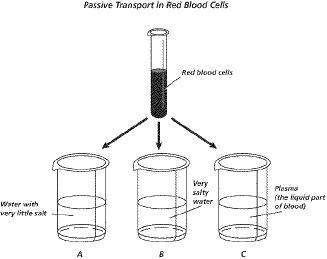100 points, brainliest, and free points if you answer all correctly
1.use the diagram to...

Biology, 26.10.2019 15:43 gonzalesnik
100 points, brainliest, and free points if you answer all correctly
1.use the diagram to answer the question.
what would happen if some of the red blood cells were placed in beaker b?
water would move into the cells by osmosis, causing the cells to shrink.
water would move out of the cells by osmosis, causing the cells to shrink.
water would move into the cells by osmosis, causing the cells to swell.
water would move out of the cells by osmosis, causing the cells to swell
2.
use the diagram to answer the question.
what would happen if some of the red blood cells were placed in beaker a?
water would move into the cells by osmosis, and the cells would swell.
water would move out of the cells by diffusion, and the cells would shrink.
water would move out of the cells by osmosis, and the cells would shrink.
water would move into the cells by diffusion, and the cells would swell.
3.
what would occur if some of the red blood cells were placed in beaker c? recall that red blood cells normally float in plasma.
the concentration of water inside and outside the cells would be equal, so no osmosis would occur.
the concentration of water inside and outside the cells would be equal, so no diffusion would occur.
the concentration of water inside the cells would be less than outside, so the cells would swell.
the concentration of water inside the cells would be greater than outside, so the cells would shrink.
4.
what is a function of water in a cell?
producing lipids and carbohydrates
assisting in the production of proteins
the cell move and grow
preventing rapid temperature changes
5.
the cell membrane and water are both involved in
directing the cell’s activities and functions
the movement of materials into and out of the cell
preventing chemical reactions from taking place
making and packaging proteins for the cell
6.
the cell membrane and water are both involved in
directing the cell’s activities and functions
the movement of materials into and out of the cell
preventing chemical reactions from taking place
making and packaging proteins for the cell
7.
which are types of passive transport?
osmosis and diffusion
diffusion and engulfing
transport proteins and osmosis
engulfing and transport proteins


Answers: 1


Another question on Biology

Biology, 21.06.2019 23:00
Seen in some gram-positive bacilli, occurs when only the inner portion of a cell wall is deposited across the dividing cell. this new cross wall puts tension on the outer layer of the old cell wall. eventually, the outer wall breaks at its weakest point with a snapping movement that tears it most of the way around. the daughter cells can then remain hanging together almost side by side being held by a small remnant of the original outer wall. choose from the following statements the ones that correctly discuss reproduction using binary fission in a bacterial cell. select all that apply. view available hint(s) select all that apply. due to the stretching of the cytoplasmic membrane, both cells will contain a complete genome. each daughter cell will contain an equal number of organelles. the daughter cell will be a permanently smaller copy of the mother cell but will contain a complete genome. each daughter cell is an exact copy of the other, both genetically and morphologically
Answers: 1

Biology, 22.06.2019 05:10
Which of the following is not a potential result of deforestation?
Answers: 2

Biology, 22.06.2019 09:50
Which statement describes compounds a. compounds are made of one type of atom. b. compounds cannot be represented by models. c. compounds are represented by chemical formulas. d. compounds cannot be broken down into simpler forms.
Answers: 1

Biology, 22.06.2019 10:30
If your client can successfully complete two or more repetitions above the desired repetition range in the last set in two consecutive workouts for any given exercise, the load should be depending on your client's current physical abilities. increased by 1-5% increased by 2-10% increased by 5-15% increased by 10-20% none of these
Answers: 1
You know the right answer?
Questions


Chemistry, 14.11.2020 01:20


Spanish, 14.11.2020 01:20

Mathematics, 14.11.2020 01:20



Mathematics, 14.11.2020 01:20

Mathematics, 14.11.2020 01:20




Mathematics, 14.11.2020 01:20


Mathematics, 14.11.2020 01:20


Mathematics, 14.11.2020 01:20



History, 14.11.2020 01:20



